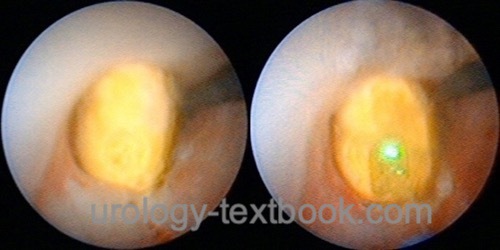You are here: Urology Textbook > Surgery (procedures) > Laser technology
Laser Technology in Urologic Surgery
Basic Principles of Lasers
A laser (acronym for Light Amplification by Stimulated Emission of Radiation) is a light-emitting device that uses the physical principle of stimulated emission to produce a high-energy beam of light. This beam is used for coagulation and cutting in medicine.
Stimulated emission:
An atom excited by energy can emit the previously supplied energy in the form of another photon through the contact of a photon if the energy difference between the two photons corresponds exactly to the difference between the excited atom and the atom at rest (for more details, see quantum physics textbooks). The additional photon has the same characteristics (direction, energy) as the triggering photon, resulting in a laser beam with a narrow frequency spectrum and parallelism of the radiation.
The technical implementation of the laser usually uses a medium (gas, liquid, or crystal) that is excited with energy. When photons with the appropriate energy act on this excited medium, additional photons are released and the photon beam is amplified. Depending on the activation of the medium, a continuous wave or pulsed wave is created. As most energy is released as heat, lasers with high energy require sophisticated cooling mechanisms.
Laser fibers:
Most systems use fiber optic laser fibers to control the laser beam. Depending on the application, the laser beam emerges straight (end-fire) or angled (side-fire).
Laser Applications in Urologic Surgery
Neodymium:YAG laser:
A neodymium-doped yttrium-aluminum-garnet crystal is used as a medium; the wavelength of the laser beam is 1064 nm (infrared light). Neodymium:YAG laser is poorly absorbed by water or body pigments, leading to a relatively large penetration depth of up to 10 mm into the tissue, in which thermal coagulation necrosis and good hemostasis occur. High energy Neodymium:YAG laser, however, may achieve surface carbonization and vaporization of the tissue.
Urological applications of the Nd:YAG laser:
- Laser coagulation of small skin tumors (genital warts, penile carcinoma)
- Laser coagulation of bladder tumors
- Urethrotomy or ureterotomy for strictures
- Visual laser ablation of the prostate (VLAP) is an obsolete, side-fire laser application with tissue coagulation under vision. Micturition improved after the necrotic tissue was rejected.
- TULIP: transurethral ultrasound-guided laser-induced prostatectomy. The technique is no longer used due to the lack of direct visualization of the laser effects.
| Do you want to see the illustration? Please support this website with a Steady membership. In return, you will get access to all images and eliminate the advertisements. Please note: some medical illustrations in urology can be disturbing, shocking, or disgusting for non-specialists. Click here for more information. |
Potassium titanyl phosphate (KTP) laser:
The medium used is a potassium titanyl phosphate crystal. The wavelength of the laser beam is 532 nm (green light, twice the frequency of the Nd:YAG laser). The laser beam is strongly absorbed by hemoglobin, and the perfused tissue reacts with vaporization. The penetration depth in well-perfused tissue is 1–3 mm.
Urological applications of the KTP laser:
- Laser vaporization of the prostate with good coagulation.
- Laser enucleation of the prostate: The prostate adenoma is mobilized into the bladder after incisions with the laser fiber, morcelated, and retrieved.
 |
Holmium:YAG laser:
The medium used is a holmium-doped yttrium-aluminum-garnet crystal; the wavelength of the pulsed laser beam is 2100 nm (infrared light). The laser beam is well absorbed in water within a few millimeters, creating a vaporization bubble. The holmium laser has a good cutting effect on the tissue through vaporization. The coagulation depth is approximately 2–3 mm. The vaporization bubble is helpful for tissue dissection and enables effective stone lithotripsy.
Urological applications of the holmium laser:
- Urinary stone lithotripsy: URS or percutaneous nephrolithotomy
- Urethrotomy or ureterotomy for strictures
- Holmium laser enucleation of the prostate (HoLEP): The prostate adenoma is mobilized into the bladder after incisions with the laser fiber, morcelated, and retrieved.
- Laser coagulation or en-bloc resection of bladder carcinoma
 |
Thulium:YAG laser:
The medium used is a thulium-doped yttrium-aluminum-garnet crystal; the wavelength of the continuous wave laser is around 2000 nm (infrared light). The laser beam has properties similar to the holmium laser, but the cutting effect on the tissue is better. The coagulation depth is approximately 2 mm.
Urological applications of the thulium laser:
See holmium laser.
Carbon dioxide laser:
CO2 is used as the medium; the wavelength of the continuous wave laser is around 10000 nm (infrared light). Instead of a laser fiber, a mirror articulated arm is used for the application. The laser beam is well absorbed by water; the penetration depth in the tissue is less than the Nd:YAG laser.
Urological applications of the CO2 laser:
Laser coagulation of small skin tumors (genital warts, penile carcinoma).
| Laparoscopy in urologic surgery | Index | Small bowel anastomosis |
Index: 1–9 A B C D E F G H I J K L M N O P Q R S T U V W X Y Z
References
R. M. Kuntz, “Current role of lasers in the treatment of benign prostatic hyperplasia (BPH),” Eur Urol, vol. 49, no. 6, pp. 961–9, 2006.
 Deutsche Version: Laser bei urologischen Operationen
Deutsche Version: Laser bei urologischen Operationen
Urology-Textbook.com – Choose the Ad-Free, Professional Resource
This website is designed for physicians and medical professionals. It presents diseases of the genital organs through detailed text and images. Some content may not be suitable for children or sensitive readers. Many illustrations are available exclusively to Steady members. Are you a physician and interested in supporting this project? Join Steady to unlock full access to all images and enjoy an ad-free experience. Try it free for 7 days—no obligation.